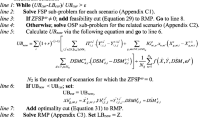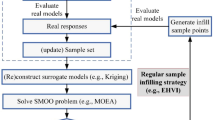Abstract
The buffer allocation problem (BAP) for flow lines has been extensively addressed in the literature. In the framework of iterative approaches, algorithms alternate an evaluative method and a generative method. Since an accurate estimation of system performance typically requires high computational effort, an efficient generative method reducing the number of iterations is desirable, for searching for the optimal buffer configuration in a reasonable time. In this work, an iterative optimization algorithm is proposed in which a highly accurate simulation is used as the evaluative method and a surrogate-based optimization is used as the generative method. The surrogate model of the system performance is built to select promising solutions so that an expensive simulation budget is avoided. The performance of the surrogate model is improved with the help of fast but rough estimators obtained with approximated analytical methods. The algorithm is embedded in a problem decomposition framework: several problem portions are solved hierarchically to reduce the solution space and to ease the search of the optimum solution. Further, the paper investigates a jumping strategy for practical application of the approach so that the algorithm response time is reduced. Numerical results are based on balanced and unbalanced flow lines composed of single-machine stations.














Similar content being viewed by others
References
Alfieri A, Matta A (2012) Mathematical programming formulations for approximate simulation of multistage production systems. Eur J Oper Res 219(3):773–783
Colledani M, Gershwin S (2013) A decomposition method for approximate evaluation of continuous flow multi-stage lines with general markovian machines. Ann Oper Res 209(1):5–40
Dallery Y, David R, Xiaolan X (1988) An efficient algorithm for analysis of transfer lines with unreliable machines and finite buffers. IIE Trans 20:280–283
Dolgui A, Eremeev AV, Sigaev VS (2007) Hbba: hybrid algorithm for buffer allocation in tandem production lines. J Intell Manuf 18(3):411–420
Frigerio N, Lin Z, Matta A (2018) Multi-fidelity models for decomposed simulation optimization. In: Rabe M et al (ed) Proceedings of the 2018 Winter Simulation Conference (WSC), Gothenburg, Sweden, pp 2217–2248
Gershwin SB (1987) An efficient decomposition method for the approximate evaluation of tandem queues with finite storage space and blocking. Oper Res 35(2):291–305
Gershwin SB, Schor JE (2000) Efficient algorithms for buffer space allocation. Ann Oper Res 93(1–4):117–144
Helber S, Schimmelpfeng K, Stolletz R, Lagershausen S (2011) Using linear programming to analyze and optimize stochastic flow lines. Ann Oper Res 182(1):193–211
Hillier MS (2000) Characterizing the optimal allocation of storage space in production line systems with variable processing times. IIE Trans 32(1):1–8
Jones DR, Schonlau M, Welch WJ (1998) Efficient global optimization of expensive black-box functions. J Global Optim 13(4):455–492
Kose SY, Kilincci O (2015) Hybrid approach for buffer allocation in open serial production lines. Comput Oper Res 60:67–78
Law AM, Kelton WD (2000) Simulation modeling & analysis, 3rd edn. McGraw-Hill Inc, New York
Li J, Meerkov S (2009) Production Systems Engineering
Liberopoulos G, Papadopoulos C, Tan B, MacGregor Smith J, Gershwin S (2006) Stochastic modeling of manufacturing systems: advances in design, performance evaluation, and control issues. Springer, New York
Lin Z, Matta A, Shanthikumar J (2020) A matlab extended kernel regression toolbox. https://doi.org/10.13140/rg.2.2.16632.19206
Lin Z, Matta A, Shanthikumar JG (2019) Combining simulation experiments and analytical models with area-based accuracy for performance evaluation of manufacturing systems. IISE Trans. 51(3):266–283
Matta A (2008) Simulation optimization with mathematical programming representation of discrete event systems. In: Mason SJ et al (ed) Proceedings of the 2008 Winter Simulation Conference, IEEE, Miami, FL, pp 1393–1400
Matta A, Pezzoni M, Semeraro Q (2012) A kriging-based algorithm to optimize production systems approximated by analytical models. J Intell Manuf 23(3):587–597
McKay MD, Beckman RJ, Conover WJ (1979) A comparison of three methods for selecting values of input variables in the analysis of output from a computer code. Technometrics 21(2):239–245
Mockus J, Tiesis V, Zilinskas A (1978) The application Bayesian methods for seeking the extremum. Towards Global Optim 2:117–129
Papadopoulos C, O’Kelly M, Vidalis M, Spinellis D (2009) Analysis and design of discrete part production lines, vol 31
Sacks J, Welch WJ, Mitchell TJ, Wynn HP (1989) Design and analysis of computer experiments. Stat Sci 4:409–423
Shi C, Gershwin SB (2016) A segmentation approach for solving buffer allocation problems in large production systems. Int J Prod Res 54(20):6121–6141
Shi L, Men S (2003) Optimal buffer allocation in production lines. IIE Trans 35(1):1–10
Soyster AL, Schmidt J, Rohrer M (1979) Allocation of buffer capacities for a class of fixed cycle production lines. AIIE Trans 11(2):140–146
Stolletz R, Weiss S (2013) Buffer allocation using exact linear programming formulations and sampling approaches. IFAC Proc Vol 46(9):1435–1440
Tolio T, Matta A (1998) A method for performance evaluation of automated flow lines. CIRP Ann Manuf Technol 47(1):373–376
Wand MP, Jones MC (1995) Kernel Smoothing. Monographs on Statistics & Applied Probability. Chapman and Hall/CRC, New York
Weiss S, Matta A, Stolletz R (2018) Optimization of buffer allocations in flow lines with limited supply. IISE Trans 50(3):191–202
Weiss S, Schwarz JA, Stolletz R (2019) The buffer allocation problem in production lines: formulations, solution methods, and instances. IISE Trans 51(5):456–485
Weiss S, Stolletz R (2015) Buffer allocation in stochastic flow lines via sample-based optimization with initial bounds. OR Spectr 37(4):869–902
Author information
Authors and Affiliations
Corresponding author
Additional information
Publisher's Note
Springer Nature remains neutral with regard to jurisdictional claims in published maps and institutional affiliations.
Appendix
Appendix
This section describes briefly how to build the surrogate model using the EKR method. A MATLAB EKR toolbox (both the EKR code and a manual) can be found at Lin et al. (2020) (https://doi.org/10.13140/RG.2.2.16632.19206). More details about the method can be found in Lin et al. (2019).
Given a system configuration \(\varvec{x}\) under which the high-fidelity system performance \(y_h(\varvec{x})\) is unknown, its low-fidelity outputs \(y_{l_j}(\varvec{x}), \forall j\) are firstly corrected by scaling functions. Two scaling functions are considered:
-
1.
Additive scaling function: \({\tilde{y}}^{l_j}_i(\varvec{x})=y_{l_j}(\varvec{x})+(y_h(\varvec{x}^0_i)-y_{l_j}(\varvec{x}^0_i)),\forall i\in {\mathcal {N}}, \forall j\in {\mathcal {J}};\)
-
2.
Multiplicative scaling function: \({\tilde{y}}^{l_j}_i(\varvec{x})=\frac{y_h(\varvec{x}^0_i)}{y_{l_j}(\varvec{x}^0_i)} \cdot y_{l_j}(\varvec{x}),\forall i\in {\mathcal {N}}, \forall j\in {\mathcal {J}}.\)
where \(y_h(\varvec{x}_i^0)\) and \(y_{l_j}(\varvec{x}^0_i)\) are the outputs of the high-fidelity model and the jth low-fidelity model at the ith design point \(\varvec{x}^0_i\), respectively. Different scaling functions can be used for different low-fidelity models.
These corrected outputs are expected to have more reliable prediction performance if their scaling functions are estimated by the initial design points close to the unobserved point. Therefore, for the jth low-fidelity model, Kernel regression (Wand and Jones 1995) is used to locally fit a polynomial on the corrected data \({\tilde{y}}^{l_j}_i(\varvec{x})\) with distance-based weights. The system performance estimate at the unobserved point \(\varvec{x}\), using the jth low-fidelity model’s corrected data, has a closed form:
where \(\varvec{e}_1\) is a \((dp+1)\)-dimensional vector whose first element is 1 and the rest are 0,
is an \(n \times (dp+1)\) matrix, p is the degree of the fitted polynomial and \(\tilde{\varvec{Y}}_{l_j}=[{\tilde{y}}^{l_j}_1(\varvec{x}),\ldots ,{\tilde{y}}^{l_j}_n(\varvec{x})]^T\). \(\varvec{W_x}=\mathrm{diag}\{K_{1,\varvec{\varTheta }_1}(\varvec{x}^0_1-\varvec{x}),\ldots ,K_{1,\varvec{\varTheta }_1}(\varvec{x}^0_n-\varvec{x})\}\) is an \(n \times n\) diagonal matrix where
\(\varvec{\varTheta }_1=\mathrm{diag}\{\theta _{1,1},\ldots ,\theta _{1,d}\}\), and \(\theta _{1,k}>0, k=1,\cdots ,d\) are parameters to be selected.
Finally, the estimates from different low-fidelity models are combined with the weights related to the estimated weighted square error:
where
and \(\mathrm{tr}(\varvec{W_x})\) is the trace of \(\varvec{W_x}\). \(K_{2,\theta _2}(\cdot )\) has the following form:
where
and \(\theta _2\) is an unknown parameter to be selected.
The model parameters \(\theta _{1,k}, \theta _2\) are selected according to the cross-validation. Where \(p=1\), the estimated root square error of \(\hat{y}_{\text {EKR}}(\varvec{x})\) as an estimate of the high-fidelity response is provided as:
where
and:
Rights and permissions
About this article
Cite this article
Lin, Z., Frigerio, N., Matta, A. et al. Multi-fidelity surrogate-based optimization for decomposed buffer allocation problems. OR Spectrum 43, 223–253 (2021). https://doi.org/10.1007/s00291-020-00603-y
Received:
Accepted:
Published:
Issue Date:
DOI: https://doi.org/10.1007/s00291-020-00603-y




